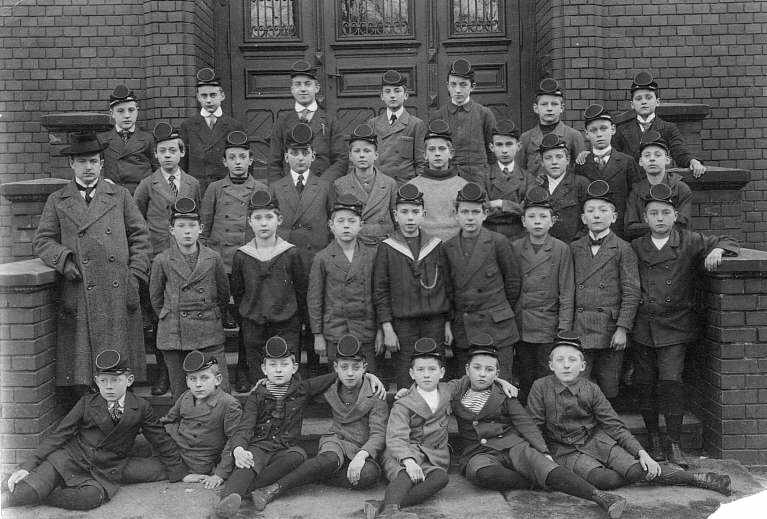
German Schoolwear: Headwear--Kepi

Figure 1.-- We suspect that some regular German state schools used the kepi, but our archive of 19th century German school impages is very limited. So we do not know how common it was. Miitary styles changed by the end of the century. We very rarely see kepis in the 20th century. One rare exceptionwas is this unidentified German school during the 1912-13 school year. Image courtesy of the BP collection.
|
|
The kepi was of French origins. It translates as "small cap". In the aftermath of the Napoleonic Wars, the French had enormous prestige in military circles. It was a style widely worn by soldiers in the mid-19th century. Americans will recognize it as the caps worn by Civil War soldiers. It was worn by German soldier at the time in conflicts like the Austro-Prussian War (1866) and Franco-Prussian WAr (1870-71). Many American military schools used the kepi as part of the uniform. We suspect the same was true in Germany. Here there were very few militry schools. We suspect that some regular state schools used the kepi, but our archive of 19th century German school impages is very limited. So we do not know how common it was. Miitary styles changed by the end of the century. We very rarely see kepis in the 20th century. One rare exceptionwas an unidentified German school in 1912-13.
School Cap
The kepi was of French origins. It translates as "small cap". In the aftermath of the Napoleonic Wars, the French had enormous prestige in military circles. It was a style widely worn by soldiers in the mid-19th century. Americans will recognize it as the caps worn by Civil War soldiers. It was worn by German soldier at the time in conflicts like the Austro-Prussian War (1866) and Franco-Prussian WAr (1870-71). Many American military schools used the kepi as part of the uniform. We suspect the same was true in Germany. Here there were very few militry schools. We suspect that some regular state schools used the kepi, but our archive of 19th century German school impages is very limited. So we do not know how common it was. Miitary styles changed by the end of the century. We very rarely see kepis in the 20th century.
Unidentified School (1912-13)
One rare exception to the lack of kepis in the 20th century was this unidentified German school. We do know the date of the portrait. It was taken during the 1912-13 school year. A HBC readers thinks it could have been the late-1910s or early 20s. Notice that some of the boys wear starched detachable collars with their suits. Others wear sailor suits with dickies. The boys seem to be about 11 or 12 and are probably from a gymnasium. Notice the school
caps, kepis with the flat circular tops. All the boys wear long black stockings with rather longish short trousers or knee pants. The picture seems to have been taken outside the school (notice the heavy
doors in the rear). We don't know the name of the school or the precise location. The cap is so destinctive we may eventually be able to identify the school.
HBC-SU

Related Chronolgy Pages in the Boys' Historical Web Site
[Main Chronology Page]
[The 1880s]
[The 1930s]
[The 1940s]
[The 1950s]
[The 1960s]
[The 1970s]
[The 1980s]
Related Style Pages in the Boys' Historical Web Site
[Main school uniform page]
[Main country page]
[Long pants suits]
[Short pants suits]
[Socks]
[Eton suits]
[Jacket and trousers]
[Blazer
[School sandals]
Navigate the Boys' Historical Clothing School Uniform Pages
[Return to the Main German school headwear page]
[Return to the Main kepi page]
[Return to the Main German 1910s individual school page]
[Australia]
[England]
[France]
[Italy]
[Japan]
[New Zealand]
[Scotland]
[United States]
Navigate the Boys' Historical Clothing Web Page
[Introduction]
[Activities]
[Biographies]
[Chronology]
[Clothing styles]
[Countries]
[Bibliographies]
[Contributions]
[FAQs]
[Glossaries]
[Images]
[Links]
[Registration]
[Tools]
[Boys' Clothing Home]
Created: 1:02 AM 1/19/2009
Last updated: 1:02 AM 1/19/2009




